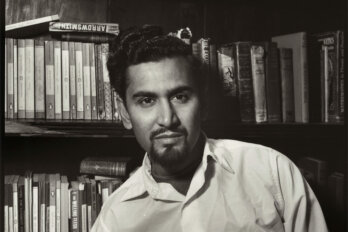My earliest memory of Canadian literature is of being in a grade seven class in the cultural hinterlands of Brampton, Ontario, where my classmates and I were required to read Hugh MacLennan’s Barometer Rising. We uniformly hated it. I recall my classmate kissing her teeth, rolling her eyes, and using it as her evidence to confirm our collective belief that “Canada was dryyyyyy.” In our early 1990s vernacular, dry signified Canada’s cultural vacuousness, complete lack of cool, and absence of style.
Nick Mount’s Arrival: The Story of CanLit works against this legacy of dryness by transforming our literature into a hothouse of eye-catching personalities. Mount is an English professor at the University of Toronto—but don’t hold that against him. Unlike many of his colleagues, he can write; using a storyteller’s pacing, he brings to life the events that comprise the explosion of literary production from 1958 to 1973—the era, in his words, of “CanLit’s original freaks and geeks.” Not only is Mount’s prose readable, but he has a Malcolm Gladwell–esque flair for mining history for little-known anecdotes.
At times, Arrival reads like you’ve bumped into the author at a bar and convinced him to give you the dirt on the Canadian icons of the 1960s. Like any good bar tale, you’re left wondering how much of it is myth and how much of it is fact. The book is meticulously researched, but Mount has read enough Stephen Leacock and Mordecai Richler to know when a story needs a hit of colour to help it along.
We learn, for instance, that the first broadcast of Alice Munro’s fiction didn’t happen because the CBC bumped her to cover the Massey Commission’s “national inquiry into the absence of Canadian writers.” (Perhaps this is how Munro honed her vaunted sense of irony?) Mount describes publisher Jack McClelland’s publicity stunts, which included “miniature jockstraps with a book about sexism and racism in professional football” and “a cocktail for The Last Spike called The Last Spike.” We also learn that the Massey Commission’s recommendations went mostly ignored until the death of two wealthy Canadians, and their giant estate tax payments, left the government with an unexpected windfall. That windfall became the seed money for the Canada Council and, in turn, council arts grants.
Where Canadian writers once toiled in isolation, suddenly they were supported by a community and an infrastructure. You could submit your feelingful lyrics to one of the little magazines proliferating across the country or one of the small presses setting up shop in Toronto. Dennis Lee, a founder of House of Anansi Press, describes the situation thus:
I had this image of people crawling up from a basement flat with manuscripts under their arms, . . . blinking their eyes, looking up and, . . . discovering that four doors over, somebody was coming up from the basement with a manuscript of their own, and somebody else was lowering a manuscript from a third-storey attic, and they had no idea that this was going on around them.
The image of a nation of closet poets rising up to claim their destiny captures something of the collective energy that powered the careers that Canadians today think of when they reflect on their literature: Munro, Margaret Atwood, Michael Ondaatje, Richler. Those biographical sketches are compelling in their own right, but Mount’s best material often comes from figures whose contributions are now underappreciated.
Robert Weaver was the “Godfather of Canadian Literature” (the moniker given to him by his biographer, Elaine Naves) and “literally CanLit’s most dedicated employee.” Between his role at the CBC Radio program Anthology and as the editor of the Tamarack Review, Weaver had access to resources that he used to keep struggling writers going. He paid for stories that he never used, wrote letters of encouragement, supported grant applications, and provided young talent with the national radio exposure that would launch their careers. Hugh Hood, Austin Clarke, Alden Nowlan, Richler, Munro, and Al Purdy all dedicated books to him. Mount convincingly demonstrates his effect on Canada’s greatest writer, Alice Munro. “It’s possible, even likely,” he writes, “that the first Canadian to win the Nobel Prize in Literature would not have kept writing without him.”
On the West Coast, Mount gives us the figures of Warren and Ellen Tallman, Americans who came to the University of British Columbia (UBC) in 1959. They brought their love of poetry with them, convincing US poet Robert Duncan to read at the UBC Festival of Contemporary Arts in 1961. The audience included George Bowering, Frank Davey, Fred Wah, among others—all major figures in Canadian poetry in the years since. “This wasn’t your usual poetry reading,” Mount writes. “This was something closer to a conversion.” It was out of those early poetic baptisms that an entire West Coast literary culture was born.
While figures like the Tallmans and Weaver helped spark some of the important moments in CanLit, the character that looms largest in Mount’s narrative is not a person but a thing: the economy. Citing John Kenneth Galbraith’s The Affluent Society, Mount’s thesis is that postwar affluence during the 1950s and 1960s funded the universities, filled the coffers of the Canada Council, made grants possible, and gave readers the disposable income to buy books. Canada, writes Mount, was a country that “after several centuries of cutting trees and swatting bugs suddenly found itself with time and money on its hands.”
He recognizes other players too: renewed nationalism, the waning influence of the British Empire, an increased awareness of the threat of American cultural domination. But for Mount, CanLit was a product of the same market forces that gave us the now-familiar narrative of baby boomers, prosperous nuclear families sitting in suburban living rooms, and the attendant “happy problems” of needing “to replace your suit because lapels are narrower this year.”
He’s right but not entirely; the economy is not the whole story. Speaking some fifty years ago, in the midst of that CanLit boom, Atwood insisted that the biggest advantage of being a Canadian writer was that there is “no longstanding tradition, because there are no huge giants . . . , you’re very free . . . the thing is wide open, you can do anything.” For Atwood, and many of her contemporaries, this aesthetic freedom had little to do with the ability to afford hash and fly to Greece (Leonard Cohen) and everything to do with being unsaddled by artistic precursors: it was the very absence of a tradition that gave Canadian writers their distinctive strength.
Alden Nowlan drew poetic inspiration from his feeling that “Sometimes I’m not even sure that I have a country.” Dennis Lee offers up something similar in his poetry collection Civil Elegies when he envisions the ghosts of Canada’s unrealized historical destiny haunting Nathan Philips Square. This is a meditation on absence that transforms lack into an articulation of community. A. J. M. Smith called this the Canadian writer’s “eclectic detachment”: the feeling of being familiar with, but not of, the great literary traditions.
More recently, Atwood, in her 2016 CLC Kreisel Lecture The Burgess Shale: The Canadian Writing Landscape of the 1960s, insists that “There are of course many strands of this past”; her metaphor of the Burgess Shale evokes a more archaeological, layered, and multiperspectival account of our literary history. She explains that “history, in my view, always begins with geology, because geology determines what you can grow and extract, where you can safely build houses . . . and so forth.” To this cultural geology she adds the women’s movement, a DIY worldview, the decreasing importance of England, anti-Americanism, and an unlikely mixture of random actors and agents that made the whole CanLit boom possible. Middle-class prosperity was merely one factor.
Beyond Mount’s overreliance on the economy argument, Arrival’s biggest weakness is an adherence to the existing narrative. He includes few careers that would challenge his account of the CanLit boom as driven by a small core of Toronto authors and publishers. With the exception of a brief mention of Trinidadian-Canadian author Harold Sonny Ladoo, Mount’s cast of characters are exceptionally white in a way that is not truly reflective of the CanLit community, even at the time. Indeed, the absence of any meaningful discussion of Austin Clarke is baffling. Clarke was an important member of the circles that Mount describes: he socialized with Purdy, Atwood, Layton, feuded with Richler, published five books during the boom, and was an early organizer in the Writers’ Union of Canada. He also enjoyed the kind of international readership denied to many of Mount’s writers. Clarke’s experience was decidedly unique, and his career has become a case study in how blackness is erased from CanLit. Including a discussion of Clarke would have enriched Mount’s analysis substantially.
Mount’s book also overlooks Indigenous writing at the time. Stephanie McKenzie, in her excellent Before the Country: Native Renaissance, Canadian Mythology, states that “During the late 1960s and 1970s in Canada there was an outburst of writing by Aboriginal peoples. The manner in which First Nations and Métis writing came to the forefront of national attention has no counterpart elsewhere in Canada’s literary history.” Her words uncannily mirror Mount’s thesis, with one important difference: she is describing Indigenous writers of the same period. Mount’s neglect of Métis author Maria Campbell—whose memoir, Half-Breed, received considerable attention at the time—blows a significant hole in his history.
Mount’s book is also strangely non-conversant with many contemporary debates that shape CanLit today. McKenzie, again, describes the Indigenous writers and activists of the 1960s “coming together, fighting for recognition and legal rights. . . . While diverse Indian nations staked land claims and protested cultural appropriation, writers and orators staked literary claims . . . . ” Sound familiar? While one can appreciate Mount’s potential reluctance to wade into the quagmire of contemporary CanLit disputes, he misses a real opportunity to link the historical struggles of Indigenous, black, and immigrant writers with today’s literary debates.
There are a few other minor complaints that may just come down to differences of opinion. One wonders whether Cohen is actually that important of a figure in Canadian writing to merit the real estate he occupies in the book. Mount’s decision to label The Double Hook “the most influential Canadian novel ever published” will be news to the vast majority of Canadians who have never (and never should) read it. His starred reviews throughout the book are daring, pithy, and entertaining, but his claim that Dennis Lee’s Civil Elegies, bpNichol’s The Martyrology, and Atwood’s The Journals of Susanna Moodie are “world classic” strains credulity.
It says something, both about the sheer breadth of the CanLit boom and Mount’s own biases, when you realize that you could construct a similarly engaging counternarrative to Arrival by focusing only on the writers Mount left out. This salon des refusés would include Marian Engel, Robertson Davies, Gabrielle Roy, and Ethel Wilson. There’s also Elizabeth Smart, Morley Callaghan, Margaret Avison, and Jane Rule. R. G. Everson isn’t here, nor is John Glassco. George Woodcock—who founded Canadian Literature—is barely mentioned. Mount, it’s true, cannot include everyone. Furthermore, he acknowledges that he is surveying the emergence of a few influential literary communities—communities that tended to be incestuous. As a result, some of the writers who worked beyond the sacred groves of downtown Toronto, Montreal, and Vancouver get left out of the picture. They simply weren’t there to dine with Weaver, talk poetry with the Tallmans, drink with Layton, drop acid at Anansi.
In this respect, where Mount’s history falters a bit is that it seems to misunderstand his own role in relation to the communities he is chronicling. He positions himself as a neutral observer of these clusters of Canadian literary activity—the authors, he argues, “literally wrote themselves into being”—when, in fact, he is very much their cultivator. By making certain exclusions and tracing particular communities at the expense of others, he is not merely describing CanLit at a crucial time of its creation; he is proscribing how that creation will be imagined for the foreseeable future. Mount’s book was marketed as part of Canada’s sesquicentennial reassessment, a reassessment that happened to coincide with a CanLit upheaval. This year will forever be marked by how the internecine fighting over Steven Galloway, Joseph Boyden, and Hal Niedzviecki led to a dramatic fragmenting of consensus in the larger literary community. It was the year, as Simon Lewsen writes, where we witnessed “CanLit breaking up with itself.” The stakes are now so high, in other words, that it’s hard to see how a book about the birth of Canada’s literary identity can justify its decision to steer away from debates about race and politics that seethed even in the 1960s.
“Literature,” wrote Northrop Frye, “is conscious mythology: as society develops, its mythical stories become structural principles of storytelling.” I would add that literary history also has a significant role to play in the mythologizing of the nation, what stories it decides to tell of its own histories, and who its principal cultural actors are.
Mount’s book has become a bestseller, and deservedly so. He has shown us that our literature is anything but boring. Many of the readers who enjoy Mount’s well-written book will also be happily affirmed in their view that the CanLit boom was the collective effort of “Margaret Laurence, mother of the tribe. Irving Layton, lusty laureate of the slums. Girl genius Marie-Claire Blais. Margaret Atwood, man-eating Medusa.” Others, however, will know that Arrival is only a part of the story. A richer, more complex, more diverse account of our literary naissance remains to be written.






